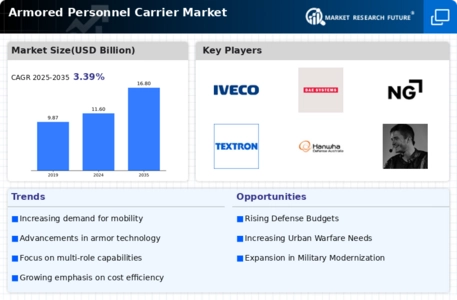The Armoured Personnel Carrier Market is characterized by intense competition and innovation among various manufacturers and suppliers striving to meet the evolving demands of defense forces globally. This market has seen significant advancements in technology, armor capabilities, and design, driven by the need for enhanced protection, mobility, and versatility in modern warfare.
Various players are investing heavily in research and development to introduce next-generation armored personnel carriers that incorporate cutting-edge technology, superior tactical capabilities, and better survivability features.
Competitive strategies include mergers and acquisitions, partnerships, and collaborations aimed at expanding product portfolios and strengthening market presence. The increasing geopolitical tensions and the necessity for improved defense capabilities are further fueling growth, with demand rising from developing nations prioritizing military modernization.
Navistar International holds a significant position in the Armoured Personnel Carrier Market, known primarily for its robust designs and reliable performance. The company leverages its extensive experience in manufacturing and engineering to develop armored vehicles that meet stringent military requirements. With a strong focus on customer-driven innovations, Navistar International has been able to tailor its products to suit the specific needs of armed forces around the world.
Its commitment to quality, coupled with an efficient supply chain management approach, enables the company to deliver effective solutions in a timely manner.
The robust reputation for durability and operational reliability enhances Navistar International's competitive standing in a market that values performance under harsh conditions. Furthermore, the company continues to focus on both vehicle capability and operator safety, making it a trusted brand in the field of armored personnel carriers.
General Dynamics is a prominent player in the Armoured Personnel Carrier Market, recognized for its advanced defense technology solutions and comprehensive service offerings. The company operates a diverse portfolio of heavily armored vehicles equipped with state-of-the-art features that meet the demanding needs of military operations.
General Dynamics prides itself on its commitment to innovation, continually enhancing its product lines to incorporate the latest technological advancements in armor protection, firepower, and situational awareness. The company's strategic approach to research and development allows it to stay ahead of emerging trends in warfare and defense requirements, positioning it as a leader in the market.
Additionally, General Dynamics benefits from a strong legacy in defense contracting, cultivated over decades, which bolsters its credibility and attracts long-term partnerships with military organizations worldwide. This strong market presence reflects the company's adaptability and resilience in addressing the challenges faced within the armored personnel carrier sector.























Leave a Comment